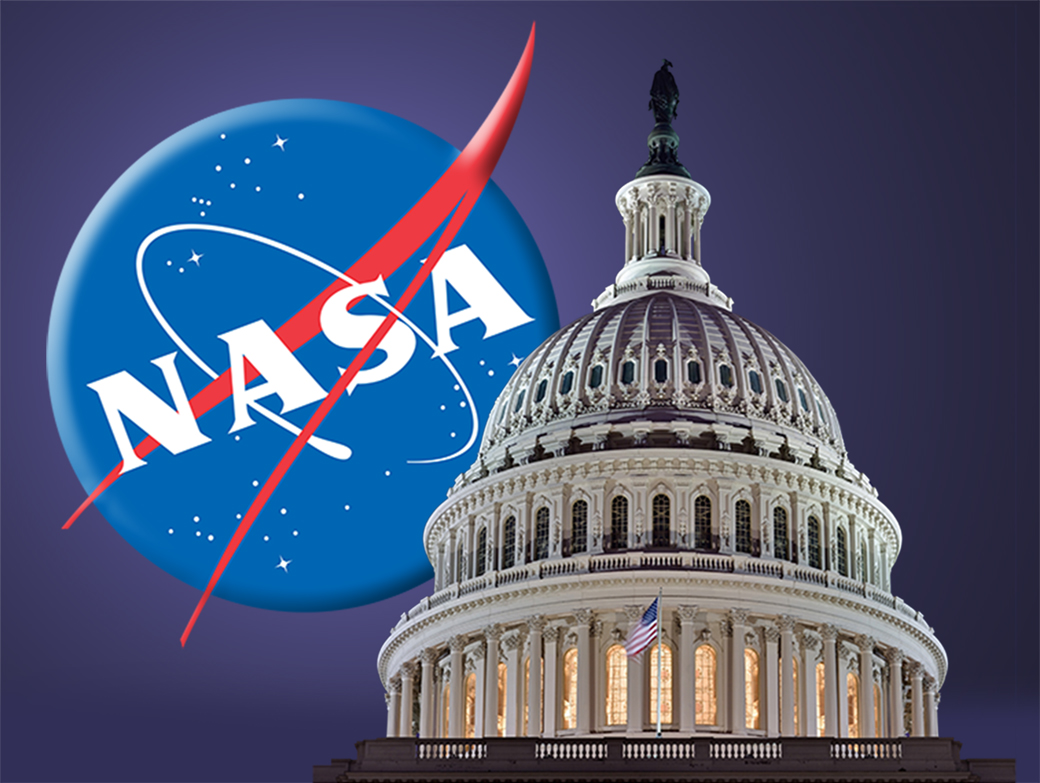Last October, an Orion spacecraft was mounted atop the Space Launch System.
Inside theVehicle Assembly Building (VAB) at NASA’s Kennedy Space Center in Florida—a cavernous structure built in the 1960s for constructing the Apollo program’s Saturn V rockets and, later, for preparing the space shuttle—the agency’s next big rocket is taking shape.
Tom Whitmeyer, NASA’s deputy associate administrator for exploration system development, recalled seeing the completed Space Launch System (SLS) vehicle there in October, after the last component, the Orion spacecraft, was installed on top. To fully view the 98-meter-tall vehicle, he had to back off to the opposite side of the building.
“It’s taller than the Statue of Liberty,” he said at an October 2021 briefing about the rocket’s impending launch. “And I like to think of it as the Statue of Liberty, because it’s very engineering-complicated piece of equipment, and it’s very inclusive. It represents everybody.”
Perhaps so. But it’s also symbolic of NASA’s way of developing rockets, which is often characterized by cost overruns and delays. As this giant vehicle nears its first launch later this year, it runs the risk of being overtaken by commercial rockets that have benefited from new technologies and new approaches to development.
NASA’s newest rocket didn’t originate in the VAB, of course—it began life on Capitol Hill. In 2010, the Obama administration announced its intent to cancel NASA’s Constellation program for returning people to the moon, citing rising costs and delays. Some in Congress pushed back, worried about the effect on the space industry of canceling Constellation at the same time NASA was retiring its space shuttles.
The White House and Congress reached a compromise in a 2010 NASA authorization bill. It directed the agency to develop a new rocket, the Space Launch System, using technologies and contracts already in place for the shuttle program. The goal was to have a rocket capable of placing at least 70 tonnes into orbit by the end of 2016.
To achieve that, NASA extensively repurposed shuttle hardware. The core stage of SLS is a modified version of the external tank from the shuttle, with four RS-25 engines developed for the shuttle mounted on its base. Attached to the sides of the core stage are two solid-rocket boosters, similar to those used on the shuttle but with five segments of solid fuel instead of four.
Difficulties pushed back the first SLS launch by years, although not all the problems were within NASA’s control.
Mounted on top of the core stage is what’s called the Interim Cryogenic Propulsion Stage, which is based on the upper stage for the Delta IV rocket and is powered by one RL10 engine, a design that has been used for decades. This stage will propel the Orion capsule to the moon or beyond after it has attained orbit. As the name suggests, this stage is a temporary one: NASA is developing a more powerful Exploration Upper Stage, with four RL10 engines. But it won’t be ready until the mid-2020s.
Even though SLS uses many existing components and was not designed for reusability, combining those components to create a new rocket proved more difficult than expected. The core stage, in particular, turned out to be surprisingly complex, as NASA struggled with the challenge of incorporating four engines. Once the first core stage was complete, it spent more than a year on a test stand at NASA’s Stennis Space Center in Mississippi, including two static-fire tests of its engines, before going to the Kennedy Space Center for launch preparations.
Those difficulties pushed back the first SLS launch by years, although not all the problems were within NASA’s control. Hurricanes damaged the Stennis test stand as well as the New Orleans facility where the core stage is built. The pandemic also slowed the work, before and after all the components arrived at the VAB for assembly. “In Florida in August and September [2021], it hit our area very hard,” said Mike Bolger, manager of the exploration ground systems program at NASA, describing the most recent wave of the pandemic at the October briefing.
Now, after years of delays, the first launch of the SLS is finally getting close. “Completing stacking [of the SLS] is a really important milestone. It shows that we’re in the home stretch,” said Mike Sarafin, NASA’s manager for the first SLS mission, called Artemis 1, at the same briefing.
After a series of tests inside the VAB, the completed vehicle will roll out to Launch Complex 39B. NASA will then conduct a practice countdown called a wet dress rehearsal—“wet” because the core stage will be loaded with liquid-hydrogen and liquid-oxygen propellants.
Controllers will go through the same steps as in an actual countdown, stopping just before the point where the RS-25 engines would normally ignite. “For us, on the ground, it’s a great chance to get the team and the ground systems wrung out and ready for launch,” Bolger said of the wet dress rehearsal.

After that test, the SLS will roll back to the VAB for final checks before returning to the pad for the actual launch. The earliest possible launch for Artemis 1 is 12 February 2022, but at the time of this writing, NASA officials said it was too soon to commit to a specific launch date.
“We won’t really be in a position to set a specific launch date until we have a successful wet dress [rehearsal],” Whitmeyer said. “We really want to see the results of that test, see how we’re doing, see if there’s anything we need to do, before we get ready to launch.”
To send the uncrewed Orion spacecraft to the moon on its desired trajectory, SLS will have to launch in one of a series of two-week launch windows, dictated by a variety of constraints. The first launch window runs through 27 February. A second opens on 12 March and runs through 27 March, followed by a third from 8 to 23 April. Sarafin said there’s a “rolling analysis cycle” to calculate specific launch opportunities each day.
A complicating factor here is the supply of propellants available. The core stage’s tanks store 2 million liters of liquid hydrogen and almost three-quarters of a million liters of liquid oxygen, putting a strain on the liquid hydrogen available at the Kennedy Space Center.
“This rocket is so big, and we need so much liquid hydrogen, that our current infrastructure at the Kennedy Space Center just does not support an every-day launch attempt,” Sarafin said. If a launch attempt is postponed after the core stage is fueled, Bolger explained, NASA would have to wait days to try again. That’s because a significant fraction of liquid hydrogen is lost to boil-off during each launch attempt, requiring storage tanks to be refilled before the next attempt. “We are currently upgrading our infrastructure,” he said, but improvements like larger liquid hydrogen storage tanks won’t be ready until the second SLS mission in 2023. There’s no pressure to launch on a specific day, Sarafin said. “We’re going to fly when the hardware’s ready to fly.”
SLS is not the only game in town when it comes to large rockets. In a factory located just outside the gates of the Kennedy Space Center, Blue Origin, the spaceflight company founded by Amazon’s Jeff Bezos, is working on its New Glenn rocket. While not as powerful as SLS, its ability to place up to 45 tonnes into orbit outclasses most other rockets in service today. Moreover, unlike SLS, the rocket’s first stage is reusable, designed to land on a ship.
New Glenn and SLS do have something in common: development delays. Blue Origin once projected the first launch of the rocket to be in 2020. By early 2021, though, that launch date had slipped to no earlier than the fourth quarter of 2022.
A successful SpaceX Starship launch vehicle, fully reusable and able to place 100 tonnes into orbit, could also make the SLS obsolete.
A key factor in that schedule is the development of Blue Origin’s BE-4 engine, seven of which will power New Glenn’s first stage. Testing that engine has taken longer than expected, affecting not only New Glenn but also United Launch Alliance’s new Vulcan Centaur rocket, which uses two BE-4 engines in its first stage. Vulcan’s first flight has slipped to early 2022, and New Glenn could see more delays as well.
Meanwhile halfway across the country, at the southern tip of Texas, SpaceX is moving ahead at full speed with its next-generation launch system, Starship. For two years, the company has been busy building, testing, flying—and often crashing—prototypes of the vehicle, culminating in a successful flight in May 2021 when the vehicle lifted off, flew to an altitude of 10 kilometers, and landed.
SpaceX is now preparing for orbital test flights, installing the Starship vehicle on top of a giant booster called, aptly, Super Heavy. A first test flight will see Super Heavy lift off from the Boca Chica, Texas, test site and place Starship in orbit. Starship will make less than one lap around the planet, though, reentering the atmosphere and splashing down in the Pacific about 100 kilometers from the Hawaiian island of Kauai.
When that launch will take place remains uncertain—despite some optimistic announcements. “If all goes well, Starship will be ready for its first orbital launch attempt next month, pending regulatory approval,” SpaceX CEO Elon Musk tweeted on 22 October 2021. But Musk surely must have known at the time that regulatory approval would take much longer.
SpaceX needs a launch license from the U.S. Federal Aviation Administration to perform that orbital launch, and that license, in turn, depends on an ongoing environmental review of Starship launches from Boca Chica. The FAA hasn’t set a schedule for completing that review. But the draft version was open for public comments through the beginning of November, and it’s likely to take the FAA months to review those comments and incorporate them into the final version of the report. That suggests that the initial orbital flight of Starship atop Super Heavy will also take place sometime in early 2022.
Starship could put NASA in a bind. The agency is funding a version of Starship to serve as a lunar lander for the Artemis program, transporting astronauts to and from the surface of the moon as soon as 2025. So NASA clearly wants Starship development to proceed apace. But a successful Starship launch vehicle, fully reusable and able to place 100 tonnes into orbit, could also make the SLS obsolete.
Of course, on the eve of the first SLS launch, NASA isn’t going to give up on the vehicle it’s worked so long and hard to develop. “SLS and Orion were purpose-designed to do this mission,” says Pam Melroy, NASA deputy administrator. “It’s designed to take a huge amount of cargo and people to deep space. Therefore, it’s not something we’re going to walk away from.”
Note: This article have been indexed to our site. We do not claim legitimacy, ownership or copyright of any of the content above. To see the article at original source Click Here













